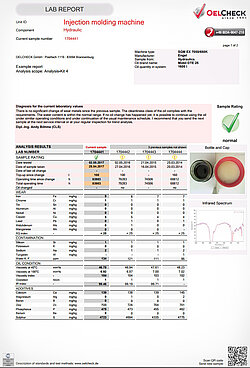
The laboratory report gives you a variety of values that inform you about the condition of the lubricant used and your machine.
The basis for a suitable laboratory report is always the Sample Information Form, which you should complete as completely as possible. Because only in connection with the information on the type of lubricant and the time of use of the oil and the details of the machine, our experienced tribologists can draw exact conclusions on the causes for changes in the lubricant.
They also use their extensive background knowledge of plants, machines, production processes and lubricants.
The evaluation of an oil sample focuses on the aspects of wear, contamination and oil condition. Increased wear values are always assigned to their cause if possible. Impurities often cause malfunctions and should be detected early to initiate countermeasures (such as oil maintenance or oil or filter changes). The oil condition provides information on whether and how long the oil can still be used.
OELCHECK also uses limit values to evaluate lubricant and operating fluid analyses. More than 200,000 machine-specific limit value tables are therefore stored in the large OELCHECK database. These also include the specifications of the OEM and other sources, but they also take into account the results of over five million lubricant and operating fluid samples that we have analyzed in our laboratory to date. Added to this is our know-how and the extensive experience we have gained thanks to intensive exchanges with countless customers
The individual commentary included in each lab report is based on wear and contamination in the oil sample and the condition of the oil. In addition, the tribologist finally answers any customer questions that may be present.


On every laboratory report, our traffic light system provides quick orientation. This means that even a non-expert can see at first glance which samples show values of concern.
The red exclamation mark
There is an urgent need for action. At least one value is in the critical range.
The yellow information sign
There are striking changes in individual values that should be monitored further.
The green tick
It's all in the green area. Send your next sample as usual.